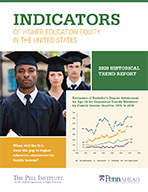 A new report published jointly by the Pell Institute for the Study of Opportunity in Higher Education of the Council for Opportunity in Education and the University of Pennsylvania’s Alliance for Higher Education and Democracy, shows how the pandemic will adversely affect the higher education opportunities of Americans from low-income families.
A new report published jointly by the Pell Institute for the Study of Opportunity in Higher Education of the Council for Opportunity in Education and the University of Pennsylvania’s Alliance for Higher Education and Democracy, shows how the pandemic will adversely affect the higher education opportunities of Americans from low-income families.
The report finds that “the lowest income students in the United States face great obstacles paying for college and the impact of the COVID-19 pandemic may compound the uncertainty such students face, particularly as federal aid covers a smaller share of college costs and most states give little in the way of financial grants to the poorest students. At the same time, for the poorest dependent students, far more family income was needed to pay for college in 2016 than even in 2008.
Among the key points in the report:
-
- Since 1990, the college participation rate for students from the lowest-income families increased from 32 percent to 51 percent. But it is still 24 percentage points lower than college participation rates in the highest income quartile.
- For every 100 low-income and first-generation dependent students entering college, only 26 will have attained a bachelor’s degree 6 years later compared with 69 percent of students who are not low-income and first generation.
- High school students whose families were in the highest income quintile were eight times as likely as students from the lowest income quintile to attend selective colleges and universities.
- Since 2008, the net price of higher education for dependent, full-time undergraduates as a percentage of family income has soared for the poorest students, going from 56 percent of family income in 2008 to 94 percent in 2016 for the lowest income quartile.
“The statistics we track in this report show systemic inequality at every step of the college journey for low-income and first-generation students. These inequalities are unmasked and made more challenging by the COVID-19 pandemic. As we recover and rebuild there is a need for bold ambitious new plans to seize this slightly more open moment as a portal to a more equitable, resilient and environmentally sustainable system,” said Margaret Cahalan, co-author of the report and Director of the Pell Institute.
The full report, 2020 Indicators of Higher Education Equity in the United States, may be downloaded by clicking here.











